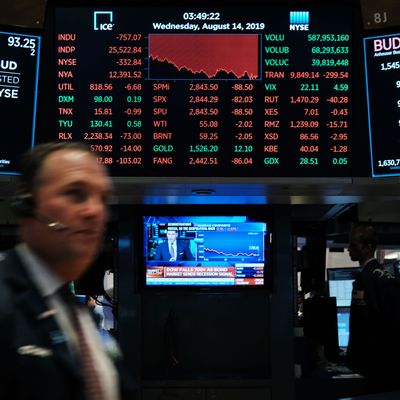
President Trump is distressed about the “CRAZY INVERTED YIELD CURVE,” and he doesn’t feel “clueless Jay Powell” (who, in case you have forgotten, is Trump’s own appointee to the chairmanship of the Federal Reserve) is doing enough to address it. The stock market, which fell 800 points today, looks pretty distressed too.
The “yield curve” refers to how interest rates on Treasury bonds change with the maturity of those bonds. If you’re lending money for a longer period, you can usually expect to earn a higher interest rate. When shorter-term bonds pay higher interest than longer-term bonds, that’s an inverted yield curve. This has often been a sign of an impending recession because it shows that investors expect interest rates to fall in the near future.
You may have been surprised to see headlines today saying the yield curve has inverted for the first time in over a decade, because you’ve probably seen the occasional headline over the past few months about the yield curve already being inverted. This is because it depends on which points on the curve you’ve looked at to measure inversion. A few months ago, the yield on ten-year Treasury bonds fell below the yield on a three-month Treasury bill. Today, the ten-year rate fell below the two-year yield, which is the yield-curve comparison most frequently used to forecast recessions.
Research analyst Jim Bianco summed up the difference between the two measures nicely on Twitter: “2yr/10yr measures econ strength … 3m/10yr measures Fed policy.” I will explain this distinction and why it makes sense to focus most on the two-year/ten-year measure.
Roughly, the interest rate on a long-term bond should be the average interest rate on short-term bonds that will prevail during the term of the long bond, plus a “term premium” to compensate the lender for risks associated with lending on fixed terms for a long period. The Federal Reserve controls short-term interest rates; it does not control long-term interest rates, but it does influence them by providing guidance about its future short-term interest-rate actions and sometimes by buying and selling bonds with longer maturities. In general, interest rates should be expected to fall when the economic outlook is weak, because fewer people will be interested in borrowing money.
So when the Fed has clearly telegraphed that it is about to cut short-term interest rates, it makes perfect sense that long-term bond yields would fall in anticipation of those cuts. Or if the Fed appears to be in denial about the need to cut rates sharply but is expected to figure it out sooner or later, that’s another reason long-term yields would fall. But the short-term bond yields themselves wouldn’t fall until changes to interest rates are truly imminent or have already happened. So if the president is talking about the three-month/ten-year when he’s yelling about the yield curve and the Fed on Twitter, he’s actually onto something, in that the Fed could get the three-month rate back below longer rates pretty easily if it cut interest rates more aggressively.
But the two-year yield … well, unlike the three-month yield, it should be pricing in any anticipated rate cuts to a significant extent, since a lot of them are likely to happen within the next two years. And assuming the Fed’s current cycle of rate cuts is just a limited “mid-cycle adjustment,” as Powell declared last month to Trump’s annoyance, the ten-year yield should price in the idea that rates will go back up at some point when the economy returns to strength.
Instead, the two-year yield is now higher than the ten-year yield. To Bianco’s point, this is less a sign about expected Fed behavior than about expected economic performance — investors expect the Fed to need to cut rates and then need to keep them low for a long time, which is why this is being treated as a recession indicator.
Or at least it’s being treated that way by some people.
“There are a number of factors other than the market’s expectations about the future path of interest rates that are pushing down long-term yields,” former Fed chair Janet Yellen told Fox Business Network today, which is a reason to think inversion is a “less good signal” of impending recession than it used to be.
In particular, low and even negative global interest rates and global economic uncertainties are driving investors worldwide to buy U.S. Treasury bonds, and all that buying pushes the yields down. There has also been a reduction over time in the typical size of the term premium, meaning the economic outlook doesn’t have to move as far from neutral as it used to for the yield curve to invert.
Ultimately, the yield curve is an indicator that reflects market participants’ assessments of certain fundamental conditions, including the economic outlook. It is not a fundamental indicator itself. As Ben Hart and I discussed on Monday, economic data and news events provide a mixed picture, with some numbers that continue to look strong (particularly employment data) while others indicators weaken and downside risks loom, particularly related to China. The inverted yield curve and the barfing stock market are two more data points showing that market participants are increasingly focused on those negative indicators and downside risks.





























